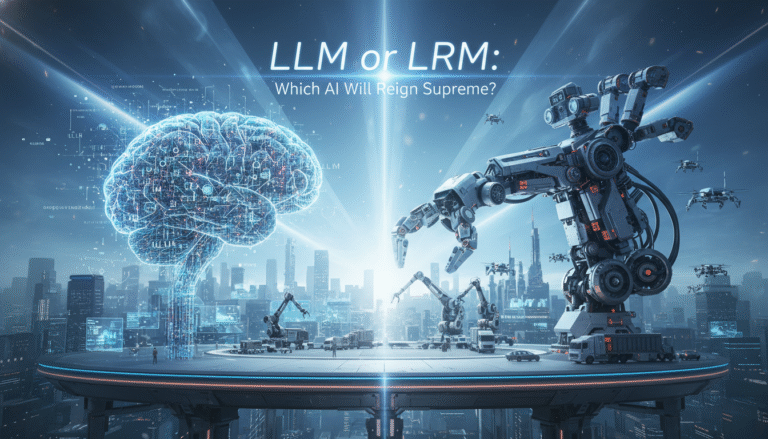AI models are changing fast, and two popular types are Large Language Models (LLMs) and Retrieval-Augmented Models (sometimes called Retrieval-Augmented Generation or RAG). People are talking about them because they help businesses and developers handle complex tasks using smart computer programs.
Knowing the difference between LLMs and RAG models matters now since more companies use AI to answer questions, write documents, and give support. Picking the right model affects how accurate, current, and useful your AI system will be.
Table of Contents
What Are Large Language Models (LLMs)?
Large Language Models are computer programs trained with huge amounts of text from books, websites, and articles. They learn patterns in language and can answer questions, write stories, and chat with people. Amazon explains LLM basics here.
Popular LLMs include GPT-4, Claude, and Llama. They work by predicting what words or sentences should come next, based on everything they learned during training. These models are great at sounding natural and handling many topics, but they only know what was in their training data. This means they might not have the latest information or details about new events.
For example, if you ask an LLM about a new product released last week, it might not have any details because it hasn’t seen that information before. Read more about LLM fine-tuning.
What Are Retrieval-Augmented Models (RAG)?
Retrieval-Augmented Generation (RAG) adds a search step to the language model. When someone asks a question, the system first searches for the latest and most relevant information from trusted sources like news articles, company databases, or web pages. Next, it gives this new information to the language model to help create an answer. See AWS explanation of RAG.
This makes RAG models better at answering questions about recent events or facts. For example, if you ask about the newest flu variant, a RAG system will search medical news and use that for its reply. Read about RAG vs Long-Context LLMs.
RAG models are helpful for things like tech support, health advice, and legal questions, where up-to-date facts really matter. Check out a business-focused look at RAG and LLMs.
How Do LLMs and RAG Models Work?
LLMs use what they learned during training to answer questions. They don’t search outside their database, so their answers might be old or miss details. For example, an LLM trained in 2023 won’t know about anything that happened in 2025 unless it’s updated.
RAG models use a two-step process. First, they search a database or the web for the latest information. Then, they use the language model to write an answer based on what was found. This makes their answers more current and accurate for fast-changing topics. See a comparison of RAG and traditional LLMs.
For more details, see this research on LLMs as retrievers.
Where Are LLMs and RAG Used?
LLMs are used for writing, chatting, brainstorming, and making summaries. They’re good for general tasks and can handle lots of topics.
RAG models are used in places where facts matter and things change quickly. Examples include answering health questions, legal advice, and customer support where answers must be reliable and up-to-date. IBM’s guide to RAG.
Many companies now use RAG in chatbots, help desks, and search tools to keep answers fresh and accurate. Microsoft’s RAG demo.
Performance and Cost
LLMs are fast and don’t need extra steps, so they can be cheaper to run. But their answers can be less accurate for new topics.
RAG models do more work by searching for information before answering. This can use more computer power and take longer, especially if the database is large. However, their answers are usually more reliable for facts and recent events. Article comparing cost and efficiency.
LLM vs RAG: Detailed Comparison Table
| Feature | LLM | RAG Model |
|---|---|---|
| Data Source | Trained on static data (past documents, books) | Fetches current data from external sources and databases |
| Accuracy for Recent Events | Limited to training data (may miss latest info) | Can answer using up-to-date info |
| Typical Uses | General chat, writing, summarizing | Customer support, health info, technical help |
| Speed and Cost | Faster, lower cost (no search step) | Slower, higher cost (extra search step) |
| Fact Checking | Can make mistakes if facts have changed | Better at giving verified answers |
| Flexibility | Good for many topics, not always accurate | Best for areas where facts change often |
For another view, see this beginner’s guide to LLMs and RAG.
Real-World Examples
Companies in healthcare use RAG models to answer medical questions using the most recent studies and guidelines. Read about RAG in healthcare.
Legal firms use RAG to give advice based on the latest laws and court rulings. Stanford’s AI Law Lab.
Tech support uses RAG models to help customers with up-to-date answers. Microsoft Copilot’s RAG system.
Conclusion
LLMs are fast and flexible, good for general tasks and creative work. RAG models are better for areas where facts matter and information changes all the time. Picking the right one depends on your need for up-to-date answers and how much accuracy matters for your use case.
As AI grows, we’ll see more hybrid systems that blend both approaches. This lets companies get the best of both worlds—speed and creativity from LLMs, plus accurate, current answers from RAG. For more updates, check TechCrunch’s latest coverage on AI models.

